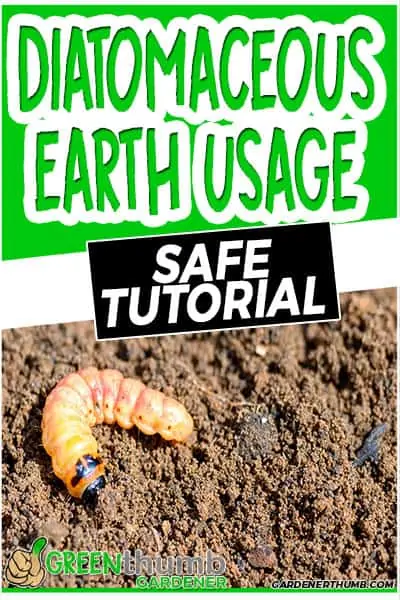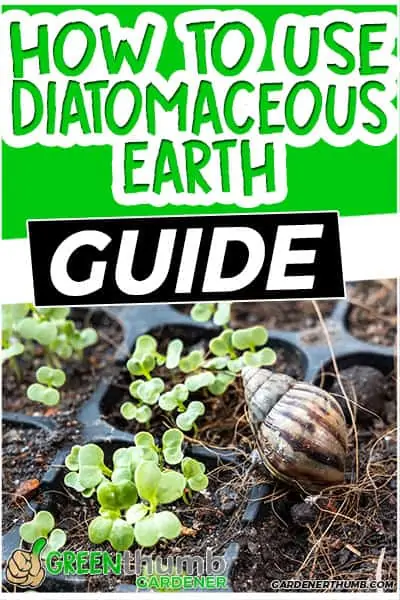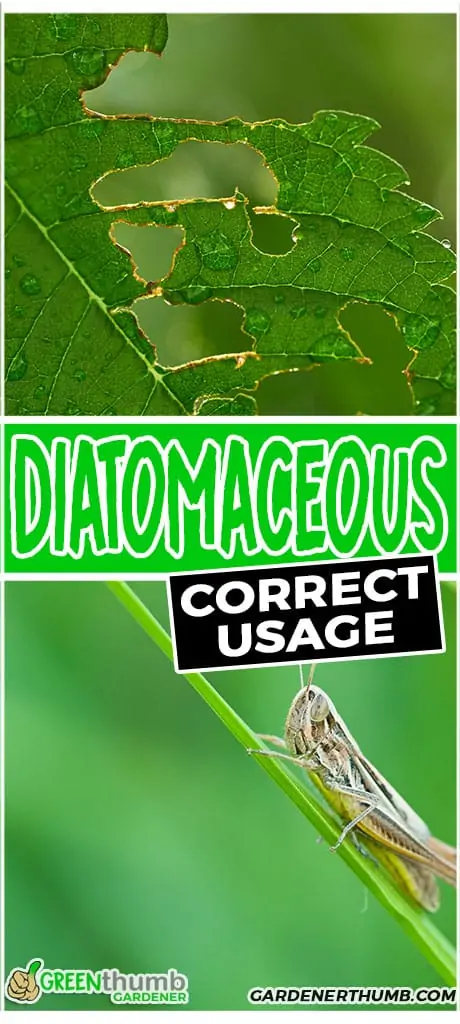How To Use Diatomaceous Earth
Last updated: 07/08/22
Pests can be a big problem in your garden. Using chemical pesticides to remove them may not be the best option.
Certain chemical fertilizers have been suspected of causing various adverse health effects such as chemical poisoning, hypertension, strokes, kidney failure, and cancer.
The great thing is there are natural options you can use to control some of these troublesome pests. Using diatomaceous earth in the garden can is an excellent alternative to using chemical fertilizer.
Green thumb Gardener occasionally links to product and/or services offered by vendors to assist you with all your gardening needs. Some of these may be affiliate links, meaning we earn a small commission if items are purchased.
Want to Download a Garden Hack Guide for FREE

Enter your email below and we will send you a guide to help you SAVE money in your garden.
What is Diatomaceous Earth (DE)?
Diatomaceous Earth is a porous, powdery, soft, and silica-rich mineral that is usually found in fossilized deposits near bodies of water that have dried off.
Peter Kasten first discovered Diatomaceous Earth while he was drilling a well. Alfred Nobel eventually used it as an ingredient for making dynamite.
Diatomaceous Earth is made from fossilized remains of algae called diatoms. These aquatic organisms have cells that have a high silica content, and when they dry up, they produce fossils that are very high in silica.
Types of Diatomaceous Earth
Diatomaceous earth is not poisonous but always follow the label instructions when you use them. Try to take steps to minimize exposure.
Food grade diatomaceous earth is a natural product composed of ground Diatomaceous Earth Amorphous Silica. It’s an organic, natural insect killer. It kills pests by physical action and not chemical use so it’s relatively safe.
Diatomaceous Earth has many uses and contains about 80% to 90% silica. Silica has two forms, crystalline and amorphous.

Food Grade
Food grade DE is used as an insecticide and anti-caking agent in the food and agriculture business. It contains around 0.5 to 2% crystalline silica and is approved for use by the FDA, USDA, and EPA. They are most often in amorphous form.
If used as correctly and as instructed, they are safe for humans. They are low in crystalline silica and relatively safe for people.
They are often used for insect control and animal feeds.
Food grade diatomaceous earth is now a becoming popular food supplement whit claimed health benefits such as improving bone health, cleansing the digestive tract, lower cholesterol levels, and cardiovascular health.
- Natural Product – Composed of 5lbs of 100% ground freshwater diatomaceous earth with absolutely no additives or fillers.
- OMRI Listed – Listed with the Organic Minerals Research Institute, a non-profit organization that reviews products against organic standards.
- Powder Duster Included – Powder duster in the bag for easy and efficient application of diatomaceous earth on animal feed
- Made in the USA – Mined in Nevada and packaged in Georgia. Does not contain an expiration date.
Filter Grade
Filter Grade DE is toxic to mammals and is typically used for industrial uses. They are often used for water filtration to filter heavy metals and in the production of dynamite.
They contain about 60% crystalline silica and are non-food grade. Since Filter Grade DE is high in crystalline silicon, it can be toxic to humans.
So you have to be careful in reading the labels and use only a food-grade DE.
Diatomaceous Earth as a Natural Pesticide
Diatomaceous Earth is often used for pest control. There are around 150 registered products for gardens, farms, pet kennels, and outside buildings.
Some of these products are being used against common pests such as common flea, ticks, bed bugs, cockroaches. In the garden, they are often used to remove beetles, worms, ants, slugs, and other garden plant pests.
When diatomaceous earth gets in contact with an insect its silica removes the insect’s outer waxy coating. Insects will not be able to retain water if this outer coating is removed and therefore becomes dehydrated and dies.
Diatomaceous Earth is easy to use and inexpensive. They are relatively safe If you used them correctly.
Other Uses of Diatomaceous Earth
Diatomaceous Earth is a natural product used for many applications after its discovery. They were so robust that the Ancient Greeks used them to make building materials for their ancient structures. It, later on, became also popular in Europe for many industrial uses.
People also used Diatomaceous Earths in their skin or teeth.
For example, it is used as an ingredient for skin care products used to remove dead skin cells. It is also an ingredient for toothpaste that is used for brushing the teeth.
Food Grade Diatomaceous Earth is also a popular filler to prevent lumping in foods, paints, plastics, and medicine.
They are also used for indoor pest control.
Diatomaceous Earth is also used in water filters to remove metals from water and clean up spills. They also are used for insulation for many industries.
Is DE Safe For Your Garden?
Diatomaceous Earth is not poisonous but always follow the label instructions when you use them. Try to take steps to minimize exposure.
Food Grade Diatomaceous Earth is a natural product composed of ground Diatomaceous Earth Amorphous Silica. It’s an organic, natural insect killer. It kills pests by physical action and not chemical use, so it’s relatively safe.
But of course, you have to use it with caution because it can still irritate the lungs, eyes, and skin when improperly handled.
Effects of Exposure to Diatomaceous Earth
If you accidentally breathe in diatomaceous earth, it can irritate your nasal passages and nose. Take necessary precautions similar to what you do when you in a dusty environment and wear a dust mask and eye protection.

Cover your nose and mouth when using the product since if you inhale too much, it can cause cough and shortness of bread. It can also cause some skin irritation.
Your lungs rapidly eliminate amorphous diatomaceous earth after inhalation. But, crystalline diatomaceous earth may accumulate in the lymph nodes and lung tissue since they are smaller.
Extended exposure to crystalline diatomaceous earth was found to cause chronic bronchitis, silicosis, and other respiratory ailments.
There were also animal studies that exposed mice to 1 hour a day of breathing diatomaceous earth for a year and noted an increase in lung cancer.
Please do note that most adverse effects are from crystalline and not from the amorphous diatomaceous earth. Only low amounts of crystalline diatomaceous earth are found in pesticide products.
How Do You Apply Diatomaceous Earth Safely?
Diatomaceous earth can be used as a natural garden pest control. Before placing Diatomaceous earth make sure you are using the food-grade type DE which is safe for humans and animals. This will ensure that people and pets around you are not adversely affected.
Food-grade type DE has been tested to be relatively safe for humans if used properly. Check the label for proper instructions and to check whether you are using food-grade DE.
Wear Proper Gear
Food grade diatomaceous earth is safe for humans. However, it can still irritate the eyes, skin, nasal passages, and lung tissue, so you have to wear proper attire.
One of the critical actions of diatomaceous earth is to dehydrate insects to get rid of unwanted pests. However, it can also dry out your skin. Always remember to wear gloves when you are handling PE to prevent dryness, especially on exposed parts of your hands.
Wear a breathable mask so you can avoid inhaling it, especially when you’re sprinkling it. Wear safety goggles or glasses to prevent them from going to your eyes.
Do not apply when there are kids and elderly, and make sure the area is cleared of people and pets.
How to Properly Apply Diatomaceous Earth
When you are purchasing diatomaceous earth, make sure you read the instructions on the label. It would be a great idea to talk to the store where you bought it and ask for tips on how to use it properly.
Diatomaceous earth used for pest protection can be applied using an approved dust applicator. When you’re dusting, make sure to apply it on both the top and underside of the foliage.
There are two major ways of applying Diatomaceous earth: the dry application and the wet application method.
Dry Application Method
The dry application method is the most common way of applying Diatomaceous earth. But make sure you apply it when it’s dry outside since rain or sprinklers will wash it away. You can use a common kitchen item such as a flour sifter to help apply diatomaceous earth to your garden plants.
Sprinkle the powder using your hands or flour sifter onto the stems and leaves of plants to protect and kill pests. If you see the bugs, you can directly sprinkle on them.
You can also spread the DE around the base of your plant to control snails, slugs, beetles, and other bugs that can damage your plants.
Sprinkle DE on the paths and garden entrance to prevent crawling pests from going to your plants.
You have to reapply the diatomaceous earth powder when it rains or when there is heavy dew in the morning because they will wash out your powder.
Be careful not to kill beneficial insects such as bees. You can cover your treated plants for few days to avoid contact with bees. Wash your plants after a few days so that they will not kill beneficial insects.
Wet Application Method
The Wet Application Method is a good alternative to using a dry powder. This method works well if you want to spread diatomaceous earth to tight and usually locations such as cracks, and other nooks and crannies.
- Mix four tables spoon of Diatomaceous earth for every gallon of water. You can add a small amount of dishwashing liquid to help it stick more to the leaves.
- Mix well until all the powder is dissolved in water
- Using a hand spray apply it to the affected areas of your garden.
Wet application is effective because it helps it adhere to the leaves of the plants. However, wet diatomaceous earth will not kill the insects. It still needs to dry up before it becomes effective.
Other Safe Ways To Help Control Pests In Your Garden
It’s inevitable, and your garden will attract many types of pests from beetles, worms, beetles, slugs, and other insects. Using pesticides chemical can harm you and the environment. So it’s best to find a safer way to control garden pests.
Prevention is key, but when they are already in your garden and causing havoc, the following can help you control them :
- Remove Japanese beetles, skunks, raccoons, and snakes using garden lime. Place garden limes on the leaves and around the garden perimeter to repel these pests.
- Try companion planting, for example, plant basil besides a tomato plant or pepper plant so it can help repel mosquitoes, spider mites, and flies. Herbs like coriander, chives, and thyme are good companion plants.
- Use natural fertilizers because they help activate soil microbes and can help the plant grow strong and healthy. Chemical fertilizers sometimes kill these beneficial microbes.
- Avoid using chemical pesticides that kill beneficial insects. Attract helpful insects because they can feed on garden pests and keep harmful bugs away.
Final Thoughts
Diatomaceous earth is a natural, affordable, and effective way of removing pests that ruin your garden. It can be used outdoors and indoors and are easy to apply to affected areas.
They contain no harmful chemicals that may affect your family and pets. Just make sure to check the label and see whether you’re using food-grade diatomaceous earth.
Related Questions
What are the potential health concerns of DE?
Anyone who is particularly sensitive to particulates (such as those with asthma or any other type of breathing condition) will want to avoid directly breathing in the dust.
How do you get rid of fleas with DE?
After you find your first flea, liberally sprinkle DE on your carpet and other cloth surfaces, and allow it to sit for a minimum of 12 hours before vacuuming.
What should I do if bees visit my plants?
If your garden happens to be attractive to bees, you may consider covering any treated plants with a sheet during the day when bees visit. You can also make certain you don’t sprinkle DE on the flower petals as that is where bees will typically land.
What if squash beetles lay eggs, does DE help with that?
No, it won’t kill the eggs. It is only effective on the larvae or hatched insects. If we see eggs, we act! Using gloved hands, carefully remove the eggs, being careful not to tear the leaves.










